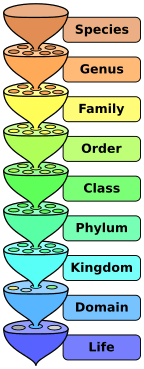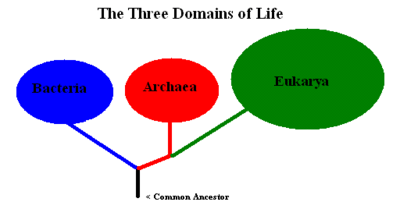Domain (biology) facts for kids
In biological taxonomy, a domain (also superregnum, superkingdom, or empire) is a taxon in the highest rank of organisms, higher than a kingdom.
Domain (or its synonyms) is the most inclusive of these biological groupings. The arrangement of taxa reflects the fundamental evolutionary differences in the genomes. There are several modern alternative domain classifications of life. Among them are:
- The 'two-empire' system, with top-level groupings of Prokaryota (or Monera) and Eukaryota empires.
- The six-kingdom system with top-level groupings of Protista, Archaebacteria, Eubacteria, Fungi, Plantae, and Animalia.
- The three-domain system of Carl Woese, introduced in 1990, with top-level groupings of Archaea, Bacteria, and Eukaryota domains.
After defining Archaea as a new domain, Woese redrew the taxonomic tree. His three-domain system is based upon genetic relationships. It divides life into 23 main divisions in three domains: Bacteria, Archaea, and Eukarya. Archaea are neither bacteria nor eukaryotes. Looked at another way, they are prokaryotes that are not bacteria.
Related pages
Images for kids
-
Phylogenetic tree showing the relationship between the eukaryotes and other forms of life, 2006 Eukaryotes are colored red, archaea green, and bacteria blue.
See also
 In Spanish: Dominio (biología) para niños
In Spanish: Dominio (biología) para niños





